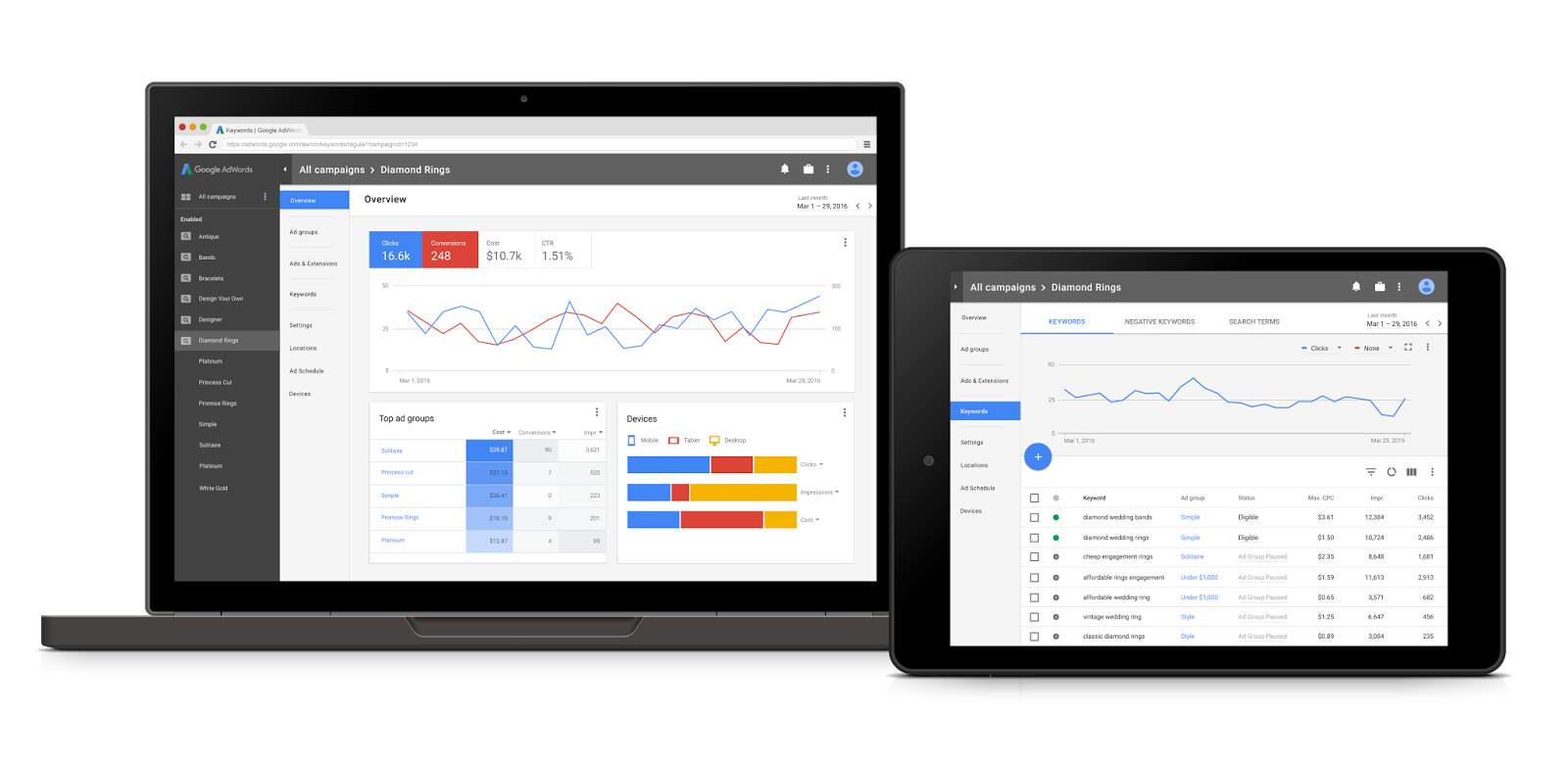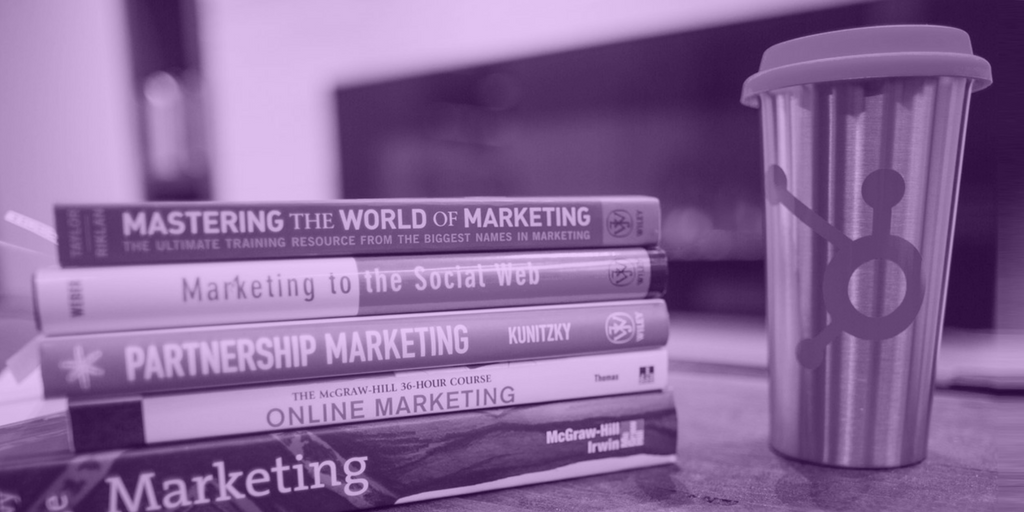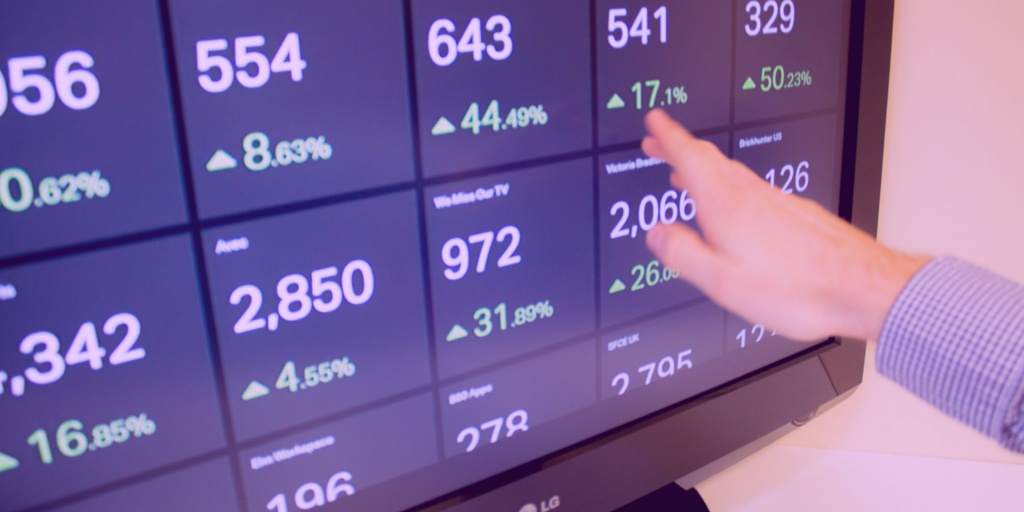If you’re anyone like me, you probably woke up to a surprise this morning when you discovered a...
For a long time, there was disdain towards PPC from those professing the inbound marketing methodology. The coiners of the term inbound marketing, HubSpot, threw it in with the likes of cold calling and billboard ads as broken, impersonal and interruptive marketing.
In the last two years, I have noticed that disdain turn into acceptance. PPC, like it or loath it, is necessary for, at least, accelerated inbound marketing success. The biggest signal perhaps being HubSpot’s release of their PPC Add-On, allowing users to create and analyse PPC without the inbound marketing platform.
In my opinion, social media ads have been the key driver behind this change in attitude with their rise in popularity and functionality, allowing marketers to target personas with ease.
For me, however, there has always been a logical connection between inbound marketing and PPC, which when used together brings amazing results. While social media ads have the most natural connection in this piece I will discuss why we can’t forget Google Adwords and how that fits into this equation.
Why is Adwords a good fit for inbound marketing?
Budget control, ability to track everything and ease of use are just some of the reasons why millions of companies advertise on Adwords, but for the specialist inbound marketer here are my top 3 reasons why you should:
-
Targeting - With 90% of the world's internet users seeing Adwords ads (over 1 billion users every month) and the ability to target by not only keyword intent (which is powerful for targeting the right stages of the buyer's journey) but also people’s geography, sites they visit, videos they watch, content they consume on your site, interest groups and more - you can be sure to reach your target personas.
-
Testing - There are a lot of elements to test with inbound marketing - call to action click through rate, landing page conversion rates and workflow effectiveness to name a few. There is nothing worse than meticulously planning your email automation only to sit and wait months for your organic efforts to kick in and provide you with that statistical assurance of effectiveness (or not). PPC can be used to drive traffic to these assets, pretty much instantly, to find out their rates and run subsequent tests for improvement - all before your first few organic prospects cast their eyes on it.
-
Traction - Inbound marketers live in a slow burn world, we are always building for the future, looking 6-9 months ahead. But your boss, and therefore your own targets, more than likely have a short term element. Adwords can provide you with the quick wins needed to get your boss off your back and allow your organic inbound to mature, ensuring no-one pulls the plug early.
What’s changed with Adwords and what are our opinions on The Google Network?
In the not so distant past Google looked something like this...
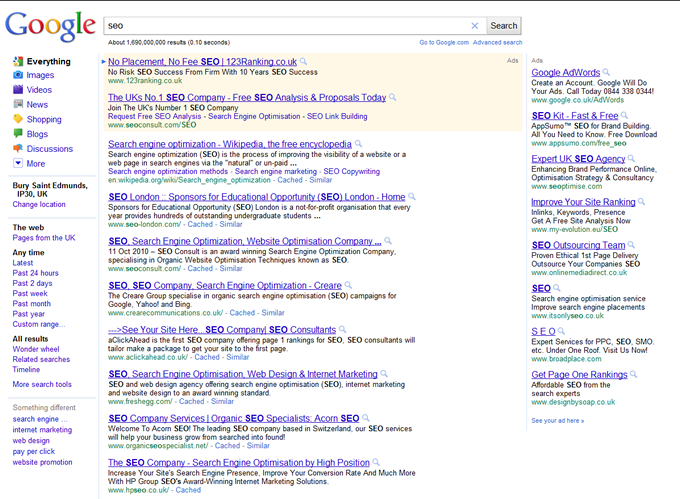
10 organic results, 10 paid - life as a search marketer, looking back with rose tinted glasses, was pretty straight forward.
Today...
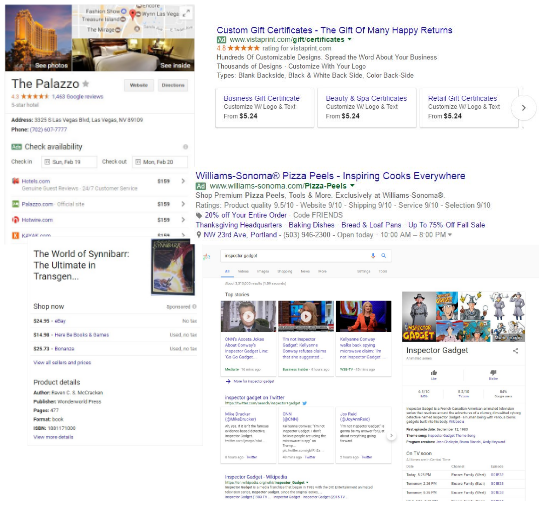
So what are these ‘new’ features?
The Google Network, as Google refers to the suite of channels you can use with Adwords, is split into two broad areas; Search and Display.
Search
The search network contains:
-
Text ads
-
Extended text ads
-
Shopping
-
Maps
-
App ads
-
Call-only ads
Display
The display network contains:
-
YouTube
-
Gmail
-
Video
-
Image
-
Rich media
-
App ads
This wealth of options has led to a lot of confused search marketers but it shouldn’t. It should lead to a lot of marketers seeing the opportunity that, today, you can get your ad in front of anyone, with the right content and at the right stage of the buyer's journey.
All you need to know is which Adwords ‘product’ to use for each stage of the inbound methodology...
How Adwords and Inbound Marketing align
The buyer's journey
The buyer's journey, below, is the cornerstone of inbound marketing - allowing us to plan and target content for the prospects context.
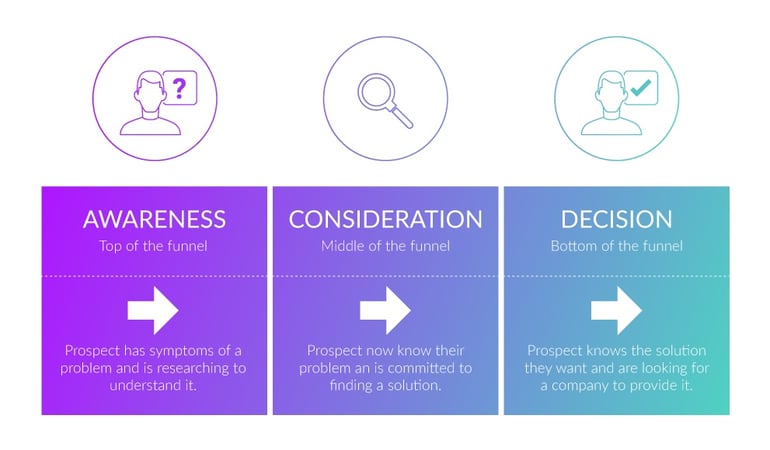
Awareness
At the awareness stage, you want to hit the largest database size at the cheapest cost, while still having control who sees the ad so it can be targeted to your persona. The two best options to do this are Display ads (video, image and rich media) and YouTube ads.
With these options you can chose to pay on a cost per thousand impression rather than per click, allowing for maximum impressions. You can also use your persona research to target the correct people and context, drilling down to the types of sites and video these personas engage with.
Example:
A great example is The BBQ Guys. They targeted prospects interested in grilling with this 30 second advert - which drives you to more content and to subscribe to their channel (which I admit I actually did!), not to the store. Thus using the viewer's context and driving you down the buyer’s journey…
Consideration
At the consideration stage I recommended bringing in search ads (Text ads and Extended text ads). As you will know from your buyer's journey research, your personas at this stage tend to compare, a lot, but aggregate sites are difficult to displace in the SERPs organically so you can target these (and other key phrases) via PPC.
If you have a strong creative team you can also continue to use YouTube at this stage, but you really do have to create solid, educational content to answer the considerations your personas will have.
Remarketing via Display (video, image and rich media) is your final weapon of choice here. You want to target those who have engaged with your awareness content and show them consideration content pieces, thus driving them down the buyer's journey.
Example:
Here’s an example from The Blog Starter…
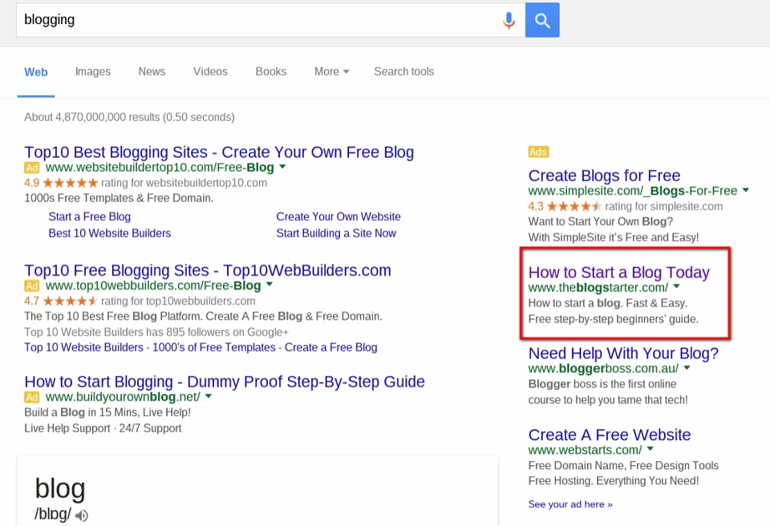
A person searching for blogging is likely to be in the consideration stage, having been aware they have a traffic problem they could be considering blogging as an option to solve that problem.
This ad takes you to a guide on how to make a blog, not trying to sell a blogging service or hosting platform directly. A great example of understanding searcher context and tying Adwords in with inbound marketing.
Decision
Finally, the decision stage. Decision based PPC is likely to be the one everyone has dipped their toe into, attempting to attract people who are ready to buy.
At this stage the key is being able to precisely target intent, knowing they are in fact ready to buy because the cost per click at this stage will be by far the most expensive.
I would recommend using search ads (Text ads and Extended text ads, and, where applicable to your business model, Shopping, Maps and Call-only ads) alongside Gmail ads, as these give you the best intent targeting options.
On the display side, remarketing can again drive those who have engaged with your consideration based content to show them a decision piece, again driving them further down the buyer's journey.
Example:
In this example AO.com, Currys and other electronics sellers are using Google Shopping ads...
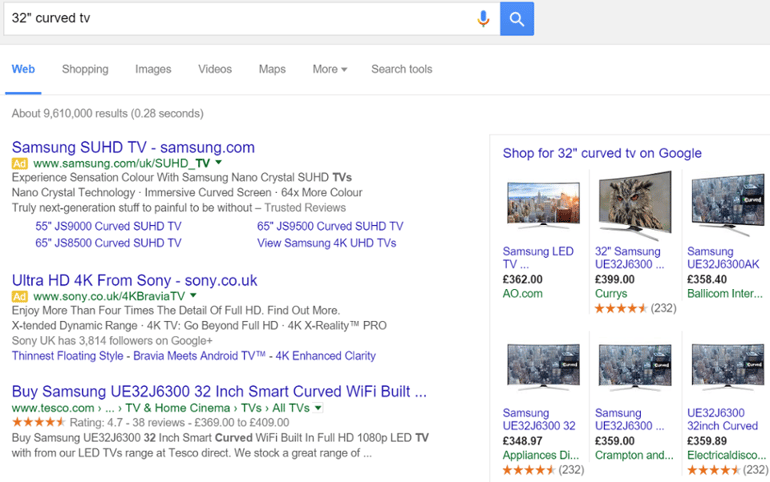
What they do well here is understand the user knows exactly what they want - a TV, curved and 32” - that’s pretty precise. Knowing this they serve up ads with those exact product specs, not trying to upsell a 48” screen, believing this prospect has a good chance of converting.
The inbound marketer in me would maybe suggest here producing a guide to the best 32” curved TVs so the user can make an informed decision on the brand and model they might want to go with but the likelihood here is the search query is far enough into the decision stage to convert.
In summary…
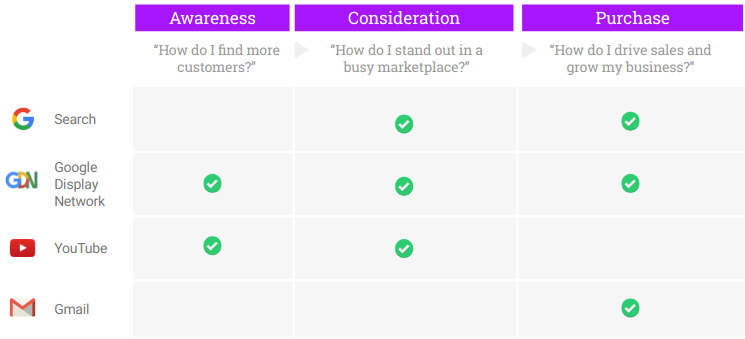
Inbound-y ads
Before you go away and start (or increase) your Adwords activity alongside your inbound marketing, a word of warning - we are still inbound marketers, we want to do things the ‘right’ way, so make sure you ads are inbound-y.
PPC + Inbound = Inbound-y Ads!
to keep us on the straight and narrow we created the following criteria for classifying your ads as inbound-y and staying true to the inbound way...
- The ad is shown to the right people, at the right time
- The ad presents a direct solution to a search query / problem
- The ad moves the searcher further down the Buyer's Journey
At least two of the above must be true for the ad to be considered 'inbound-y'.
Key takeaways
- Adwords can be used to speed up inbound marketing
- There are more than a dozen ‘products’ in Adwords today, make sure you are selecting the right ones for each stage of the buyer's journey
- Awareness = Display ads (video, image and rich media) and YouTube ads
- Consideration = search ads (Text ads and Extended text ads), YouTube and Remarketing
- Decision = search ads (Text ads and Extended text ads, and where applicable to your business model Shopping, Maps and Call-only ads), Gmail ads and Remarketing
- Keep your ads inbound-y!
But don’t just remember these three takeaways. You will get the best results if you make full and proper use of your PPC findings to shape your inbound campaigns and efforts too. Take that early PPC traffic to your inbound content and learn from how they react. This means, once your organic traffic starts to arrive, you will have sharpened and honed your inbound content.
Add all of this together and it’s easy to see why PPC is no longer the black sheep of the digital marketing family in the eyes of many inbound marketers.
But it doesn't just stop there with using Google AdWords for Inbound. Grab your copy of our Secrets to Inbound Marketing eBook, containing everything from utilising the entire Paid Network to getting the most out of HubSpot, don't miss out on these quick wins!
